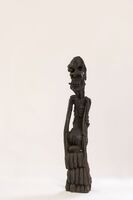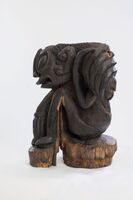-
Title
-
AR_0001_Field Spirits of the Fante
-
Description
-
These objects, linked to a period of approximately 1870-1940, offer a glimpse into the subtle influence of colonial oversight. Field spirits were crafted to protect women and children, homes, crops, domestic animals, and providers (hunters) and also displayed warnings to those venturing onto protected lands, fields, homes, or pilfering from the property owner. The reliance on such objects indicates that longstanding conversion to Christianity among the Fante did not replace traditional beliefs about the security of homes, crops, domestic animals, and people.
These examples of field spirits are rare because they were tools, not created to be objects of art, but crafted to offer specific protection and security for the people who placed them in the fields. Environmental exposure and insects, particularly termites, destroy wooden objects in West Africa very quickly. It is precisely because such field spirits were normally left in the fields that very few remain.
-
Date
-
1870-1940
-
Medium
-
Wood
-
Rights
-
All rights reserved. The use of any part of these objects and photographs transmitted in any form by any means, electronic, mechanical, photocopying, recording, or otherwise, or stored in a retrieval system without the prior written consent of MEBA is an infringement of the copyright law.
-
Subject
-
African Agriculture Ghana 1870-1940
 AR_0001_03_0008_Sentry to the fields The spirit stands above the plantain and holds the crop between his legs in the same way that older spirits protected the home and lamb. However, in contrast to the older spirits, the spirit itself shows evidence of violence, decay, and death. Perhaps this is a message of how far the spirit would go as a sacrificial servant whose duty is to protect the crop at any price
AR_0001_03_0008_Sentry to the fields The spirit stands above the plantain and holds the crop between his legs in the same way that older spirits protected the home and lamb. However, in contrast to the older spirits, the spirit itself shows evidence of violence, decay, and death. Perhaps this is a message of how far the spirit would go as a sacrificial servant whose duty is to protect the crop at any price AR_0001_03_0003_Protector of the crops Also known as 'Guardian of the plantain', the calm serene face of the serpent in the 'Protector of the crops' is similar to the face of the lamb being protected by the 'Protector of the flocks of sheep'.
AR_0001_03_0003_Protector of the crops Also known as 'Guardian of the plantain', the calm serene face of the serpent in the 'Protector of the crops' is similar to the face of the lamb being protected by the 'Protector of the flocks of sheep'.